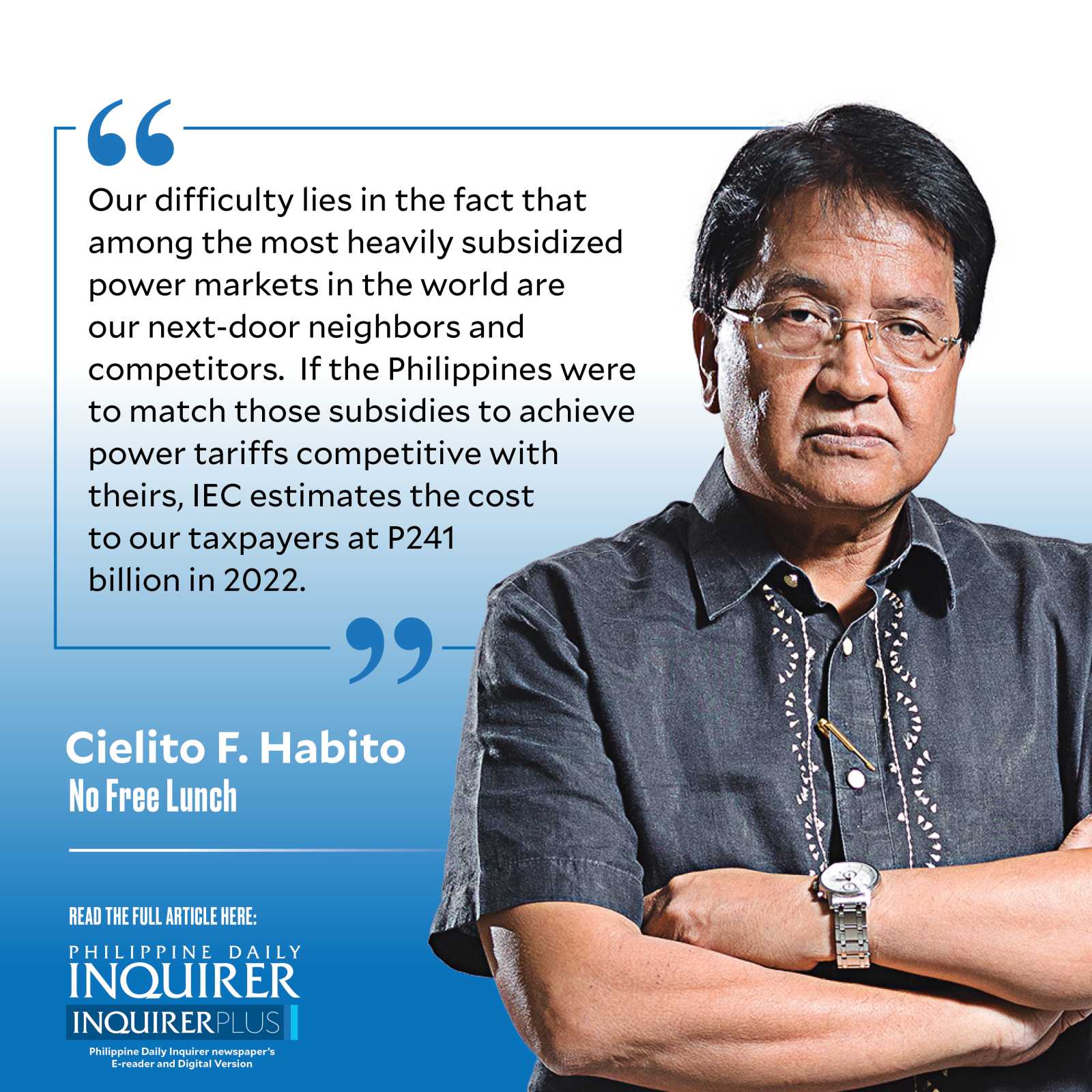
Are Filipinos paying too much for electric power? Is that why we can’t attract as much foreign direct investments (FDI) as our Asean peers do?
Most of us have heard the lament that we have the second most expensive power in Asia. Most people seem to accept it as an unquestionable fact. With it goes a misplaced notion that our power industry is highly inefficient, and we should thus be able to bring down power rates to the level of our neighbors, where they pay as little as half. Last week, I saw the results of a recent cross-country study by Australia-based International Energy Consultants (IEC) that examined power costs in 44 countries and two US states. Of these, 18 (including the Philippines) have verifiable data that permit a closer examination of power costs. Data for the Philippines were based on costs and tariffs of Meralco, as the dominant distribution utility. IEC has done four of such cross-country studies since 2012, with the most recent one released in February this year, based on November 2022 data. I found the study useful and interesting as it clarifies some common myths and misconceptions, and highlights some interesting facts about the Philippine power sector.
Is our power sector unduly inefficient? There may have been a time when it was, but IEC’s latest comparative numbers actually show that based on Luzon data, our cost of supplying electricity (covering generation, transmission, and distribution) is actually 7 percent below the world average. IEC notes that the generation charge (which is 71 percent of the tariff paid by Meralco customers), at 13.42 US cents per kilowatt-hour (c/kWh), is significantly below their 16.00 c/kWh estimated long-run marginal cost of producing our wholesale electric power. This savings is attributed to Meralco’s ability to source low-cost power supply agreements. The distribution charge of 2.56 c/kWh, which accounts for 14 percent of the Meralco bill, was found to be 33 percent below the average for the 46 markets. Of the 1.01 c/kWh transmission charge (5 percent of the total bill), IEC notes that “given the geography of the network area and the cross-subsidy for non-Meralco customers, this is probably fair and reasonable.” Our taxes and other charges (1.81 c/kWh) represent 10 percent of the total tariff, which is much lower than the average 21 percent imposed in the 46 markets surveyed. All told, the average tariffs we pay Meralco are 3 percent below the global average, which includes subsidized markets. If we exclude subsidized markets, our electricity tariffs are actually 12 percent lower than the global average—suggesting that we’re not that bad after all.
Our difficulty lies in the fact that among the most heavily subsidized power markets in the world are our next-door neighbors and competitors. Large subsidies—reportedly in the form of cash grants, subsidized fuel, or deferred expenditures—allow our Asean peers Indonesia, Malaysia, Thailand, and Vietnam to charge tariffs much lower than ours. IEC calculated the power subsidy rates across these four countries to average 52 percent in 2022, up from 46 percent in 2012, 32 percent in 2016, and 41 percent in 2018. This means that their general taxpayers actually pay for more than half of the true cost of electricity in those countries. There is no free lunch. If the Philippines were to match those subsidies to achieve power tariffs competitive with theirs, IEC estimates the cost to our taxpayers at P241 billion in 2022. Energy Secretary Raphael Lotilla has explained in forums that Indonesia, Malaysia, and Thailand “have been able to afford the subsidy because they have enough oil and coal resources,” and Vietnam is feeling the weight of their own subsidies. According to energy pundit Alex Ablaza in a recent meeting, our neighbors are already feeling heightened pressure to eliminate those costly subsidies, but political will stands in the way.
Such subsidies are hard to justify in the Philippines, where budgets are tight, and the tax system is persistently assessed to be regressive; that is, taxes overall take a larger percentage out of the incomes of the poor than of the rich. This is especially because we rely more heavily on indirect taxes (which tax spending) like the value-added tax or VAT, than direct taxes (which tax incomes and wealth). At the same time, income tax evasion and avoidance tend to be more prevalent among the rich. Thus, subsidizing our power costs would have the perverse effect of a heavier proportionate burden on the poor, who consume far less power than the rich.
Are our power costs keeping FDIs out? I recently wrote about how it’s more reliability rather than the cost of power that investors cite as a problem. It’s the other power, misused in the hands of politicians, that has cost our economy dearly over the years.
cielito.habito@gmail.com